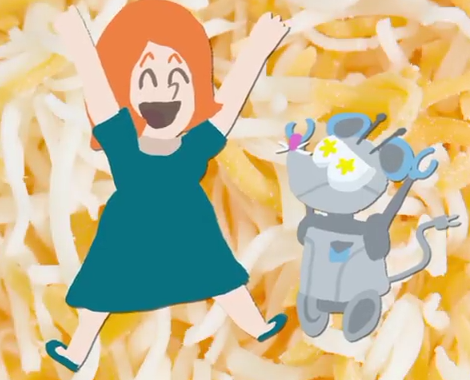Hey, Squeaks! How about we have a little snack?
嘿,吱吱,我们吃点儿零食怎么样?
I have something in mind that I think you'll really like!
我想到了一样东西,觉得你会喜欢它!
This snack comes from a cow, but it's not milk!
这种零食出自奶牛,但它不是牛奶!
Though it's actually something that's made from milk.
不过它确实是由牛奶制成的。
That's true, we've made butter from milk before … but it's not that, either.
没错,我们之前用牛奶制过黄油,但它不是黄油。
Yep! It's cheese! This is Swiss cheese!
答对了!是奶酪,这是瑞士奶酪!
It's called that because it was originally made in Switzerland, which is a country in Europe.
它得此名是因为它源产自欧洲国家瑞士。
But now Swiss cheese is made all over the world, including here in the United States.
但现在,瑞士奶酪在世界各地都有生产,包括在美国。
You might notice something about this cheese that you don't normally see in other foods: it has all those holes!
你可能注意到了,这个奶酪有些东西不同于你平时在其他食物看到的:它上面全都是孔!
Most other types of cheese don't have holes in them, so Swiss cheese is pretty special.
大多数其他类型的奶酪里面没有孔,所以瑞士奶酪相当特别。
Cheese experts actually call these holes "eyes,"
奶酪专家称这些孔为“眼睛”,
which is kind of funny because they're totally different from our eyes.
这有点儿滑稽,因为它们与我们的眼睛截然不同。
So why does Swiss cheese have "eyes"?
那么瑞士奶酪为什么有“眼睛”呢?
Is it because Squeaks has been nibbling at it?
是因为吱吱在上面咬的吗?

I'm just kidding, Squeaks! The holes in Swiss cheese aren't made by animals!
吱吱,我只是开玩笑!瑞士奶酪上的孔不是动物造成的!
Let's get to the HOLE story! Get it, Squeaks? Hole?
让我们去看孔的故事!吱吱,明白了吗?出现孔的原因?
The really cool thing about cheese is that it's actually made with germs!
奶酪最酷的是它实际是用细菌做得!
Yeah, that's right: germs!
是的,是细菌!
Another word that scientists use to talk about these germs is bacteria,
科学家们用于谈论这些细菌的另一个单词是“bacteria”,
and there are some kinds of bacteria that can make us sick.
有些种类的细菌可以致病。
But the bacteria in cheese is safe!
但奶酪中的细菌是安全的!
Cheesemakers add different types of bacteria to milk, along with some other stuff, to make different types of cheeses.
奶酪制造商在牛奶中加入不同类型的细菌以及其他物质,以制作不同类型的奶酪。
And there are so many! Maybe you're a fan of mozzarella?
奶酪有很多种!也许你是马苏里拉奶酪的粉丝?
That's the kind you can usually find on pizza.
这是你经常在披萨上找到的种类。
And I know we're big fans of pizza!
我知道我们都是披萨的超级粉丝!
Or maybe you like cheddar cheese?
或者你喜欢切达干酪?
Cheddar makes an excellent grilled-cheese sandwich!
切达干酪三明治非常棒!
And there are so many more! Anyway, back to Swiss!
奶酪还有好多种!不管怎样,回到瑞士奶酪的话题上!
I know you've been waiting to find out the hole story about those holes!
我知道你一直等着发现关于这些小孔的整个故事!
I know, that was a cheesy joke!
我知道,这是个俗气的笑话!
The bacteria that cheesemakers add to Swiss cheese eat some of the cheese,
奶酪制造商加到瑞士奶酪中的细菌会吃一些奶酪,
but that's not exactly what causes the holes.
但这不是形成小孔的确切原因。
When the bacteria eat the milk, they cause a reaction.
当细菌吃牛奶时,它们会引起一种反应。
A reaction is when two things mix together, and sometimes they create a third thing!
反应是指两种事物混合时,有时能创造出第三种事物!
In this case, when the bacteria eat the milk, they create … bubbles!
在这个例子中,细菌在吃牛奶时,它们会创造出气泡!
Those bubbles take up space in the cheese, and when they eventually pop, we're left with holes.
这些气泡占据了奶酪的空间,当它们最终破裂时,就留下了小孔。
Totally weird, right? But here's the thing:
非常奇怪,对吧?但问题是:
The Swiss cheese we eat today doesn't have as many holes in it as it used to,
我们现在吃到的瑞士奶酪没有过去那么多的小孔,
and sometimes it ends up not having any holes at all!
有时它根本没有任何小孔!
So what's different about the way we make Swiss cheese now?
那么我们现在制作瑞士奶酪的方法有何不同?
We're still using the same bacteria.
我们使用的仍是同一种细菌。
Scientists think there are less holes these days because the bacteria aren't doing all the work in making them.
科学家们认为现在的小孔减少是因为细菌并不能完成产生气泡的全部工作。
Little bits of hay might be helping the process along!
少量的干草可能有助于这个过程。
So what's hay? And why is it in cheese?
那么什么是干草?它为什么会在奶酪里呢?
Hay is something you'll find on a lot of farms.
干草是你在很多农场都能找到的东西。
It's dried out grass that's used to feed animals, like cows and sheep and other animals that make milk!
它是晒干了的草,用来喂奶牛、绵羊和其他产奶的动物!
So little tiny bits of hay might accidentally get into the buckets used for collecting milk.
所以零星的干草可能会不小心掉进用来收集牛奶的桶里。
Then, scientists think the bubbles from the bacteria form around those little bits of hay.
然后,科学家们认为细菌在这些小干草周围形成气泡。
So the hay is important for creating the bubbles that make the holes when they pop.
因此,干草对于产生气泡很重要,这些气泡在破裂时会形成孔。
Now that cheesemakers have more modern ways of making cheese, hay doesn't get in the buckets anymore.
现在奶酪制造商有了更现代的奶酪制作方法,干草不再被放在桶里了。
So that might be why there aren't so many holes anymore, even though the bacteria is the same.
这可能就是现在没有那么多小孔的原因了,即使细菌是一样的。
And there you have it! The mystery is solved:
你知道原因了!谜题解决了:
hay and bacteria work together as a team to make bubbles that leave holes when they pop!
干草和细菌作为一个团队一起工作,在气泡破裂时留下了小孔!
So the holes definitely aren't made by mice or rats or robot rats eating the cheese!
所以小孔绝不是老鼠或者吃奶酪的机器老鼠造成的!
Thanks for joining us!
感谢您的收看!
If you want to keep learning and exploring with Squeaks and me, hit the subscribe button,
如果你想继续学习,与我和吱吱一起探索,就点击订阅吧,
and don't forget to check us out on the YouTube Kids app.
不要忘了在YouTube Kids应用上查看我们。
Thanks! And we'll see you next time, here at the Fort!
感谢您的收看!我们下期见,沃斯堡等你哦!











